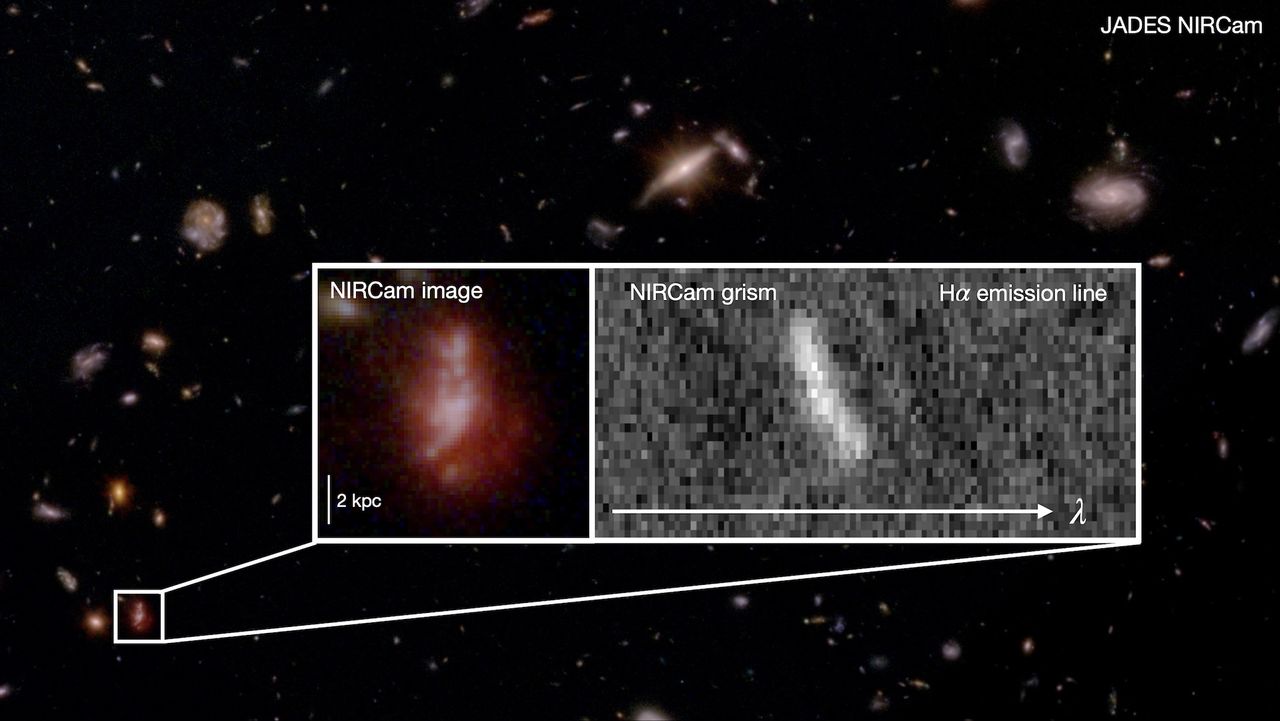Science
James Webb Telescope Reveals Chaotic Youth of Early Galaxies

A recent study utilizing the James Webb Space Telescope (JWST) has uncovered that galaxies in the early universe were significantly more chaotic than previously understood. Researchers examined over 250 galaxies formed between 800 million and 1.5 billion years after the Big Bang, revealing a turbulent phase in their development. The findings, published on October 21, 2023, in the journal Monthly Notices of the Royal Astronomical Society, provide new insights into the formative years of these cosmic structures.
Unraveling Galactic Turbulence
The study’s lead author, Lola Danhaive, a doctoral candidate at the University of Cambridge‘s Kavli Institute for Cosmology, explained that the research focused on less massive galaxies, which demonstrated what the team described as “messy kinematics.” Unlike the more stable rotating disks of galaxies such as the Milky Way, these early galaxies exhibited high levels of turbulence.
Danhaive noted that prior research had largely concentrated on larger, more ordered galaxies, which are easier to detect with telescopes. This previous bias meant that the chaotic nature of smaller galaxies went unnoticed. “We find evidence that this turbulence in the [galaxy] disk is caused by high amounts of gas, which fuels intense star formation and drives gravitational instabilities,” she stated.
The study revealed how these chaotic structures evolved into the more organized forms seen in mature galaxies today. “At early times, galaxies are undergoing a turbulent phase of assembly, where strong bursts of star formation and high amounts of gas disrupt the ordered motions of the gas disk,” Danhaive explained. Over billions of years, as galaxies consumed available gas to form stars, they became more stable and organized.
Insights from the James Webb Space Telescope
The JWST, positioned in a stable gravitational area far from Earth’s light interference, has enabled scientists to explore deeper into the universe than ever before. Its infrared capabilities allow it to analyze the earliest galaxies, providing crucial data to understand the dynamics of galaxy formation.
Danhaive highlighted how the observatory, in conjunction with simulations, enhances researchers’ understanding of “bursty” star formation and the role gas plays in shaping galaxies. “Overall, our work opens a window into the dynamics of early galaxy formation,” she remarked.
Looking ahead, the research team plans to investigate the inflows and outflows of gas in individual galaxies. By tracing the chemical enrichment of gas, they aim to differentiate between pristine inflowing gas and outflowing gas enriched by stellar contributions. This examination could reveal why certain galaxies rotate faster than others, further expanding the knowledge of galaxy evolution.
Danhaive concluded, “There is so much more to uncover with JWST’s amazing capabilities, and we look forward to exploring many more aspects of early galaxy formation.” This groundbreaking research not only highlights the chaotic beginnings of galaxies but also establishes a foundation for future studies that will deepen our understanding of the universe’s evolution.
-

 Science3 weeks ago
Science3 weeks agoALMA Discovers Companion Orbiting Giant Red Star π 1 Gruis
-

 Top Stories2 months ago
Top Stories2 months agoNew ‘Star Trek: Voyager’ Game Demo Released, Players Test Limits
-

 Politics2 months ago
Politics2 months agoSEVENTEEN’s Mingyu Faces Backlash Over Alcohol Incident at Concert
-

 World2 months ago
World2 months agoGlobal Air Forces Ranked by Annual Defense Budgets in 2025
-

 World2 months ago
World2 months agoElectrification Challenges Demand Advanced Multiphysics Modeling
-

 World2 months ago
World2 months agoMass Production of F-35 Fighter Jet Drives Down Costs
-

 Business2 months ago
Business2 months agoGold Investment Surge: Top Mutual Funds and ETF Alternatives
-

 Science2 months ago
Science2 months agoTime Crystals Revolutionize Quantum Computing Potential
-

 Top Stories2 months ago
Top Stories2 months agoDirecTV to Launch AI-Driven Ads with User Likenesses in 2026
-

 Entertainment2 months ago
Entertainment2 months agoFreeport Art Gallery Transforms Waste into Creative Masterpieces
-

 Health2 months ago
Health2 months agoGavin Newsom Critiques Trump’s Health and National Guard Plans
-

 Business2 months ago
Business2 months agoUS Government Denies Coal Lease Bid, Impacting Industry Revival Efforts









